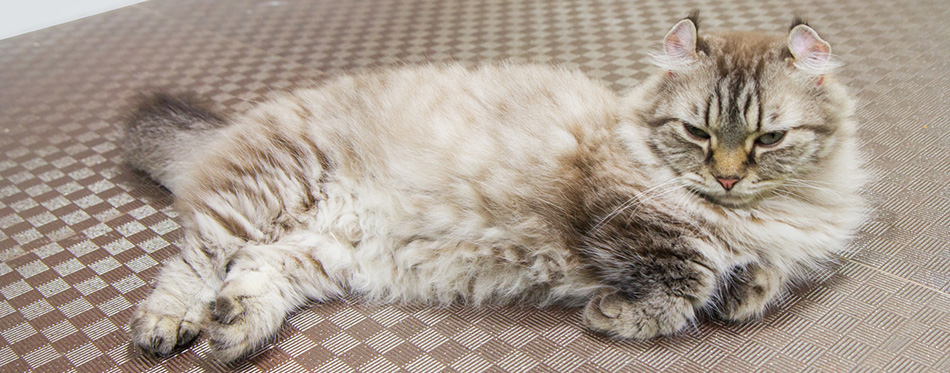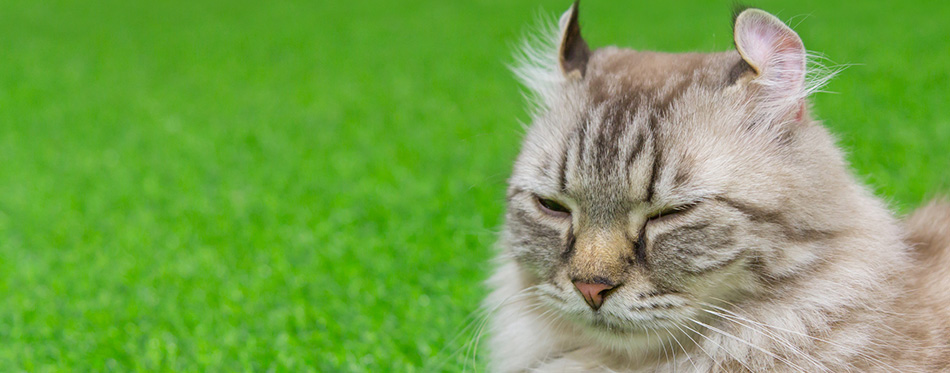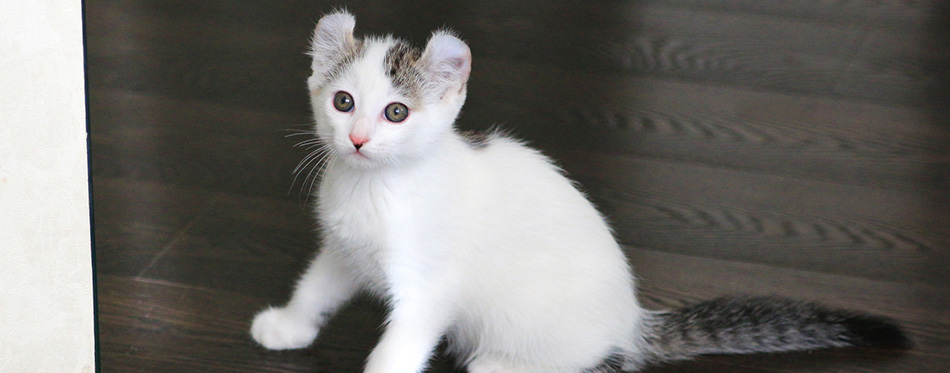The American Curl is a distinctive domestic cat characterized by its unique wispy ears that curl back, creating an alert and elegant look similar to that of a wild lynx. This beautiful and friendly cat comes from Lakewood, Calfornia, and is one of the youngest breeds in the world. Despite this, it’s one of the most popular breeds in the U.S.A. and also one of the fastest to gain recognition by the International Cat Association.
The first American Curl appeared less than 40 years ago, yet today, it is ranked 27th among the United States’ most popular cat breeds ever. It’s no wonder why – the “Curl” is adorable looking, with fluffy ears and a silky smooth coat, and gentle yet lively and playful personality. If you’re looking for a people-loving cat, you can’t get better than the American Curl. This gorgeous feline even likes children! This, coupled with their cheerful and curious personality, makes them fantastic pets for both small and big families.
Whether you’re considering buying or adopting an American Curl or perhaps gifting it to someone, this article is for you. From the Curl’s mysterious history to their health, grooming needs and diet, this blog post covers everything you need to know about this unique cat breed. We even have some quick facts about the Curl for those in a hurry!

History of the American Curl
The American Curl has a rather mysterious and interesting history. Unlike other popular breeds with long and distinct histories, the Curl’s story is short and relatively new.
In June 1981 Lakewood, California, the first American Curl came to be. A stray cat with funnily curled ears with long, silky black hair appeared on the doorstep of the Rugas family. Grace and Joe Rugas welcomed the unique-looking cat, as besides being beautiful, it was also friendly. After adopting the kitty, the Rugas family named her Shulamith after the “black and comely” princess Shulamith in the Song of Solomon in the Old Testament.
Soon after becoming a pet member of the Rugas family, Shulamith had a litter of four kittens with an unknown male cat. Two of the kittens shared her adorable curly ears and two didn’t. In addition, one of the kittens with curled ears had a shorthaired coat instead of the longhaired hair like its mother. And so, Shulamith became the foundation of the breed we now know as the American Curl.
By 1983 – just two years after Shulamith gave birth to her four kittens – people began selectively breeding the cats in an attempt to preserve the unique trait. Thankfully, genetics were on their side; a geneticist named Roy Robinson found that the curly ears trait was caused by a dominant gene, meaning cats with only one copy of this gene would be born with curled ears.
In 1987, the American Curl breed was recognized by the International Cat Association, gaining full recognition from Cat Fanciers Association (CFA) in 1993. Both the shorthaired and longhaired varieties were immediately recognized, making the “Curls” the first breed with two coats to be recognized by the CFA.
While still an uncommon breed, the American Curl is now one of the most popular cat breeds in the U.S.A. It can also be found in other countries, including Russia, Japan, Spain, France and many more.
Quick Facts About the American Curl
- Their ears begin to curl early on
Undoubtedly, curly ears are the most interesting feature of the American Curl. Wispy and usually fluffy, they begin to curl back almost immediately after a kitten is born. At only two to ten days of age, a kitten’s ears will start curling, uncurling and then curling some more until they reach their permanent shape (a minimum of 90 degrees arc, but no more than 180 degrees). This happens when a kitten is about 4 months old.
- They’re very affectionate and people-loving
If you’re looking for a friendly, warm cat, the American Curl is for you. This feline is people-oriented and enjoys spending time with their human family; however, the Curl is far from needy. Like all cats, they’re quite independent and do not need constant attention. This said, they’re very affectionate and they even like children, making them perfect pets both for large families and child-free individuals.
- They’re smart and curious
The Curls possess a unique personality in the sense that they’re curious like most other cats, but they’re also very smart so they rarely get into trouble as a result of their curiosity. They’re also known to follow their owners around the house to see what they’re doing – a trait that some pet parents find adorable, while others…a bit annoying!
- They’re expressive but not very vocal
The Curl is one of the most expressive felines around – they love to give nose kisses, face licks, slow blinks and they’re even known for looking their owners straight into the eyes while they’re speaking to them. However, they themselves are not particularly talkative. Instead of meowing and demanding attention, they will quietly petition you to notice them if left alone for too long.
- Their coat comes in a host of colors and patterns
The Curl’s coat can be both short and long, or rather medium, and can come in various colors and patterns. They can be black, white, blue, cream, brown, tortoiseshell, silver and more, and can be solidly colored, bi-colored, calicoes shaded and pointed. Regardless of their variety of colors and patterns, all Curls have soft and silky coats.
- They’re playful and can be trained
Known as the Peter Pans of the cat world, American Curls are very playful throughout their whole life. It’s not uncommon to see older Curls running around the house with just as much energy and joy as the younger cats. And because they’re very smart, they learn quickly – it’s actually hard to find a bad-mannered Curl!

Things You Should Know
Before getting an American Curl, it’s a good idea to take a few moments to learn about the breed’s health, diet and grooming requirements, as well as their general temperament. While they can be wonderful animal companions, the American Curls – like any other breed – are not for everyone. Getting a new pet should always come after thorough research so that there are no bad surprises neither for you or your new cat. Here are the most important things to know before getting an American Curl.
Health
American Curls are generally healthy cats who are not predisposed to any major genetic disorders, which is thanks to their large genetic pool with non-pedigree cats. They’re usually resilient, with well-muscled bodies and strong bones, although exactly how strong and resilient your cat will be will depend on its own line. Despite the Curl being a healthy breed, it’s important to remember that both mixed and pedigreed breeds are not shielded against developing certain health problems during their lifetime.
One thing to note about the Curls is their ears as they require special care. While undeniably cute, curly ears need frequent but gentle cleaning to prevent infections. Regular cleaning is important because many Curls are born with narrowed ear canals which are prone to wax buildup. For this reason, it’s essential to examine your kitty’s ears every week to prevent or identify any ear problems. To clean your American Curl’s ears, use a damp cloth soaked in diluted vinegar. Simply mix one part vinegar with two parts warm water, soak a clean cloth and gently clean your cat’s ears. Do this at least once a week. If you notice that your cat’s ears are constantly getting wax buildup despite regular cleaning, talk to your vet and ask for advice. For a wider selection of choices, check out our cat ear cleaners guide.
Feeding
Like all cats, American Curls should be fed a high-quality cat food that is high in protein and relatively low to low in carbohydrates. All cats need at least 26% of protein in their diets, while kittens require a minimum of 30% of protein. When it comes to American Curls specifically, diet is no different – to be healthy, cat food should contain enough protein, fat and fiber, as well as all vitamins and minerals needed for feline wellbeing. Keep in mind that you should never overfeed your cat – like all breeds, American Curls are susceptible to obesity, heart disease and diabetes if they’re fed a high-calorie diet but are not exercised.
Here are a few pointers to remember when purchasing food for your Curl cat:
- Look for animal protein – all cats are carnivores and Curls are no exception. Always stick to cat foods that contain plenty of quality animal protein first and foremost; chicken, turkey, fish, beef, pork and other meats are all good sources.
- Controlled calories: the Curl is naturally a lean, well-muscled cat and should remain like that throughout its entire life. Never buy high-calorie cat foods unless your cat is extremely active or you’ve been advised to feed such a diet by your vet. Instead, stick to average to slightly below average calorie content, depending on your cat’s physical activity.
- Low carbohydrate content: cats don’t requite carbohydrates in order to live, however, many benefit from consuming small amounts of healthy, unprocessed carbs in their diet, such as whole grains, vegetables and certain fruits like berries.
For more help on choosing the right cat food, you may wish to consider our guides on the best dry cat food, wet cat food, high fiber cat food, kitten food for your cat, organic cat food, and grain free cat food.
Care and Grooming
The American Curl’s coat can be shorthaired or longhaired, and thankfully, both types are easy to care for. The shorthaired variety doesn’t have any undercoat while the longhaired one has very little, so neither is prone to matting or tangling. That being said, it’s always a good idea to comb your cat’s coat at least once a week. This will keep their hair smooth, silky and clean and will prevent any skin and coat issues such as irritation from having dead hair accumulated in the undercoat. Shorthair Curls shed all year and slightly more than the longhaired cats. On the flip side, the longhair Curls shed more during warmer months, so more frequent brushing is recommended during summer and sometimes even spring, depending on your climate. Generally speaking though, it’s a good idea to brush the longhaired Curls twice a week anyway, simply because they have a little bit of an undercoat.
Like most cats, American Curls like to keep themselves clean and neat, so they will rarely need a bath. However, if your Curl is an outdoor cat who often comes in messy and dirty, feel free to bathe them with a pet shampoo.
To keep your cat’s teeth and gums healthy and prevent periodontal disease, it’s a good idea to brush their teeth daily. If this is not possible, brushing them once a week is better than nothing. Remember, never use human toothpaste on your pet – there are cat-specific toothpastes available which will not only clean your kitty’s teeth and gums, but will also keep them safe if they swallow it. To keep your Curl’s eyes healthy, wipe them with a soft, damp towel from time to time. Be gentle on the eyes and use a separate cloth for each eye if you notice any sign of irritation or infection.
As for the Curl’s ears, they’re the most important organs to keep clean and healthy. As mentioned, some Curls are born with narrow ear canals which are prone to wax buildup, which in turn, can lead to ear infections. To prevent any ear problems, clean your cat’s ears at least once a week, preferably two to three times a week. If you’re cleaning weekly, feel free to use a cloth soaked in diluted vinegar (one part vinegar to two parts warm water), and if you’re cleaning two to three times a week, use only a cloth soaked in warm water. The vinegar solution is excellent at removing dirt and wax buildup but can be too much for sensitive skin, so don’t use it more than once a week. Also, always be gentle with your Curl’s ears – they can be sensitive so you need to handle them carefully.
Finally, remember to keep your Curl’s litterbox clean. Like most cats, the Curls hate using dirty litterboxes so if forced to for long periods, they may stop using them completely. To avoid any bathroom problems, clean the cat litter box regularly. Scoop daily and wash the box whenever you’re changing the litter.
For more guides on cat grooming, you may wish to check out our reviews of the best cat brushes, cat shampoo, cat toothpaste, cat toothbrushes, and cat grooming gloves.

Temperament
The American Curl is a friendly, gentle and affectionate cat breed that makes for a wonderful pet. They’re known as people-loving and agreeable cats, so they fit in well in both small and big families. They even like children and other pets, including other cats and dogs, as long as the other animal is also friendly.
This well-behaved cat is smart and curious and can even be trained to play fetch. Many owners of American Curls report their pets following them around the house, not to bother them, but to see what they’re doing. This should tell you something about the Curls – they’re inquisitive pets, always ready to explore and investigate. While this is a positive trait in general, it may be a minus for some folks– people who like to keep certain things, clothes or rooms to themselves may find Curls a little too curious for their liking. They’re excellent at finding ways to sneak in areas and rooms they shouldn’t be in!
The Curls are also very affectionate and expressive. They love to be petted and (gently!) cuddled, and will greet their owners with a head bump when they come home from work. They also often stare into people’s eyes when they talk to them as if they can understand them. That being said, they will rarely speak, or rather meow back – these are not talkative cats. They’re rather quiet and well-behaved, so when in need of attention, they will almost always silently ask for it (by patting you, bumping into you or simply staring at you).
Lastly, this article wouldn’t be complete if we didn’t mention the most unique personality trait of American Curls of all – their joyful playfulness. Known as the Peter Pans of the cat world, these adorable animals remain fond of games well into their adulthood. Older Curls can often be seen flying through the house with as much energy and joy as their younger counterparts, so they’re best suited to similar people – folks who love to play with their pets and enjoy teaching them new games and tricks their whole lives.
Sources:
- About the American Curl – CFA
- American Curl Breed – tica.org
- American Curl – international cat care

